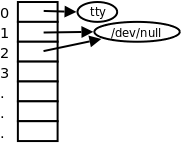先前我们以read终端设备为例介绍了非阻塞I/O,为什么我们不直接对STDIN_FILENO做非阻塞read,而要重新open一遍/dev/tty呢?因为STDIN_FILENO在程序启动时已经被自动打开了,而我们需要在调用open时指定O_NONBLOCK标志。这里介绍另外一种办法,可以用fcntl函数改变一个已打开的文件的属性,可以重新设置读、写、追加、非阻塞等标志(这些标志称为File Status Flag),而不必重新open文件。
#include <unistd.h> #include <fcntl.h> int fcntl(int fd, int cmd); int fcntl(int fd, int cmd, long arg); int fcntl(int fd, int cmd, struct flock *lock);
这个函数和open一样,也是用可变参数实现的,可变参数的类型和个数取决于前面的cmd参数。下面的例子使用F_GETFL和F_SETFL这两种fcntl命令改变STDIN_FILENO的属性,加上O_NONBLOCK选项,实现和例 28.3 “非阻塞读终端”同样的功能。
例 28.5. 用fcntl改变File Status Flag
#include <unistd.h>
#include <fcntl.h>
#include <errno.h>
#include <string.h>
#include <stdlib.h>
#define MSG_TRY "try again\n"
int main(void)
{
char buf[10];
int n;
int flags;
flags = fcntl(STDIN_FILENO, F_GETFL);
flags |= O_NONBLOCK;
if(fcntl(STDIN_FILENO, F_SETFL, flags)==-1) {
perror("fcntl");
exit(1);
}
tryagain:
n = read(STDIN_FILENO, buf, 10);
if(n<0) {
if(errno!=EAGAIN) {
perror("read");
exit(1);
}
sleep(1);
write(STDOUT_FILENO, MSG_TRY, strlen(MSG_TRY));
goto tryagain;
}
write(STDOUT_FILENO, buf, n);
return 0;
}以下程序通过命令行的第一个参数指定一个文件描述符,同时利用Shell的重定向功能在该描述符上打开文件,然后用fcntl的F_GETFL命令取出File Status Flag并打印。
#include <sys/types.h>
#include <fcntl.h>
#include <stdio.h>
#include <stdlib.h>
int main(int argc, char *argv[])
{
int val;
if (argc != 2) {
fputs("usage: a.out <descriptor#>\n", stderr);
exit(1);
}
if ((val = fcntl(atoi(argv[1]), F_GETFL)) < 0) {
printf("fcntl error for fd %d\n", atoi(argv[1]));
exit(1);
}
switch(val & O_ACCMODE) {
case O_RDONLY:
printf("read only");
break;
case O_WRONLY:
printf("write only");
break;
case O_RDWR:
printf("read write");
break;
default:
fputs("invalid access mode\n", stderr);
exit(1);
}
if (val & O_APPEND)
printf(", append");
if (val & O_NONBLOCK)
printf(", nonblocking");
putchar('\n');
return 0;
}运行该程序的几种情况解释如下。
$ ./a.out 0 < /dev/tty read only
Shell在执行a.out时将它的标准输入重定向到/dev/tty,并且是只读的。argv[1]是0,因此取出文件描述符0(也就是标准输入)的File Status Flag,用掩码O_ACCMODE取出它的读写位,结果是O_RDONLY。注意,Shell的重定向语法不属于程序的命令行参数,这个命行只有两个参数,argv[0]是"./a.out",argv[1]是"0",重定向由Shell解释,在启动程序时已经生效,程序在运行时并不知道标准输入被重定向了。
$ ./a.out 1 > temp.foo $ cat temp.foo write only
Shell在执行a.out时将它的标准输出重定向到文件temp.foo,并且是只写的。程序取出文件描述符1的File Status Flag,发现是只写的,于是打印write only,但是打印不到屏幕上而是打印到temp.foo这个文件中了。
$ ./a.out 2 2>>temp.foo write only, append
Shell在执行a.out时将它的标准错误输出重定向到文件temp.foo,并且是只写和追加方式。程序取出文件描述符2的File Status Flag,发现是只写和追加方式的。
$ ./a.out 5 5<>temp.foo read write
Shell在执行a.out时在它的文件描述符5上打开文件temp.foo,并且是可读可写的。程序取出文件描述符5的File Status Flag,发现是可读可写的。
我们看到一种新的Shell重定向语法,如果在<、>、>>、<>前面添一个数字,该数字就表示在哪个文件描述符上打开文件,例如2>>temp.foo表示将标准错误输出重定向到文件temp.foo并且以追加方式写入文件,注意2和>>之间不能有空格,否则2就被解释成命令行参数了。文件描述符数字还可以出现在重定向符号右边,例如:
$ command > /dev/null 2>&1
首先将某个命令command的标准输出重定向到/dev/null,然后将该命令可能产生的错误信息(标准错误输出)也重定向到和标准输出(用&1标识)相同的文件,即/dev/null,如下图所示。
/dev/null设备文件只有一个作用,往它里面写任何数据都被直接丢弃。因此保证了该命令执行时屏幕上没有任何输出,既不打印正常信息也不打印错误信息,让命令安静地执行,这种写法在Shell脚本中很常见。注意,文件描述符数字写在重定向符号右边需要加&号,否则就被解释成文件名了,2>&1其中的>左右两边都不能有空格。
除了F_GETFL和F_SETFL命令之外,fcntl还有很多命令做其它操作,例如设置文件记录锁等。可以通过fcntl设置的都是当前进程如何访问设备或文件的访问控制属性,例如读、写、追加、非阻塞、加锁等,但并不设置文件或设备本身的属性,例如文件的读写权限、串口波特率等。下一节要介绍的ioctl函数用于设置某些设备本身的属性,例如串口波特率、终端窗口大小,注意区分这两个函数的作用。
